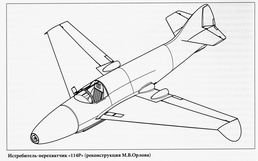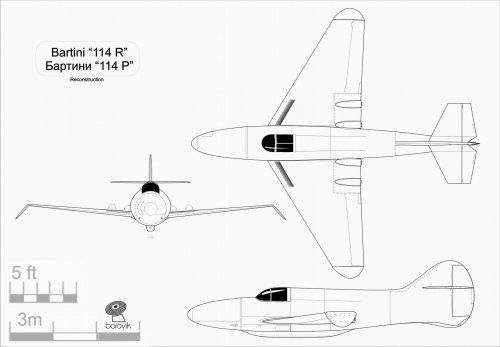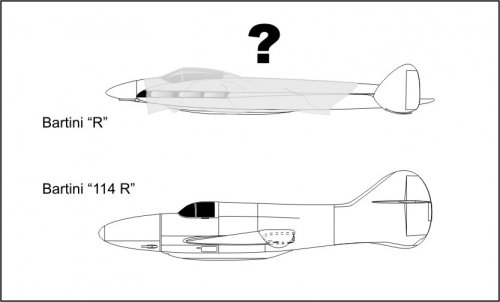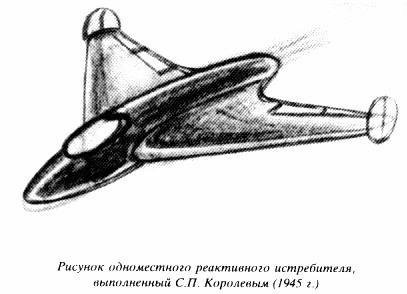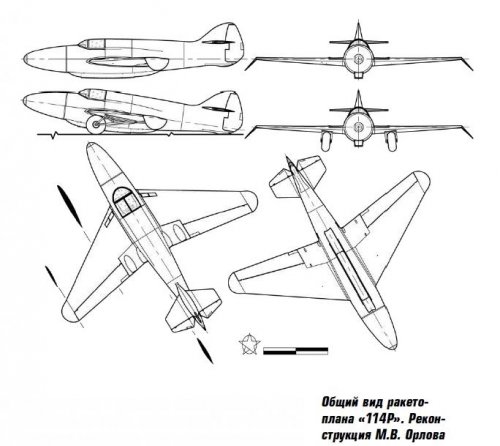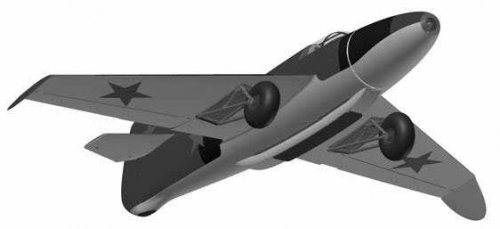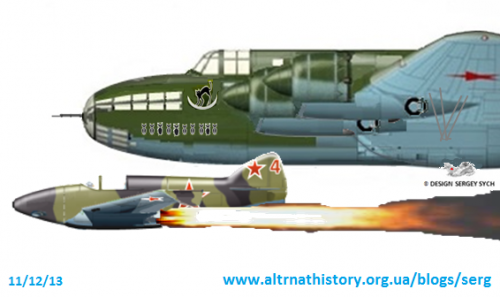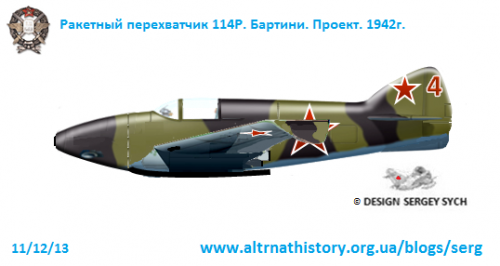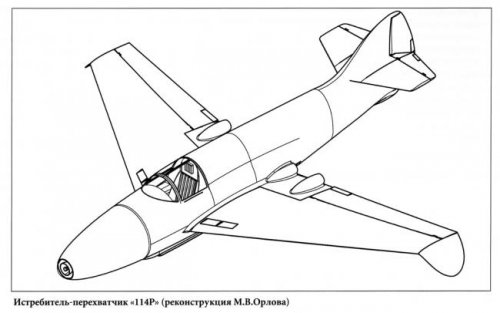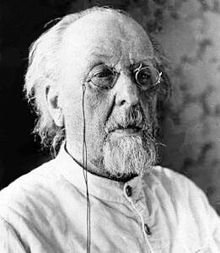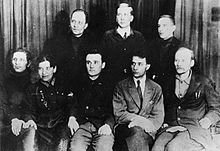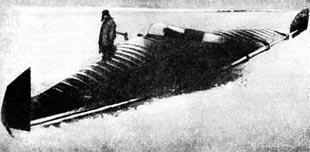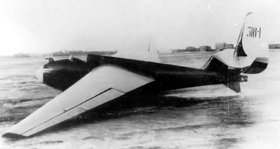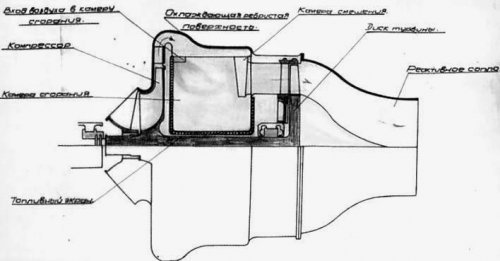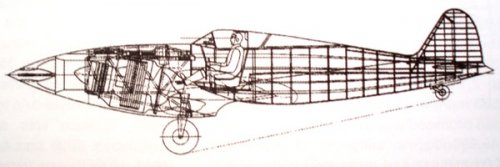You are using an out of date browser. It may not display this or other websites correctly.
You should upgrade or use an alternative browser.
You should upgrade or use an alternative browser.
Bartini 114R
- Thread starter toura
- Start date
- Joined
- 7 June 2009
- Messages
- 532
- Reaction score
- 159
The R-114 was a preliminary project of high-speed (VERY high-speed) rocket interceptor, designed at Bartini special OKB placed in Omsk. It was a swept-wing aircraft (33 deg. measured by leading edge) with boundary layer control system (!). It was powered by four rocket engines designed by V. Glushko, each producing 3 kN thrust (12 kN total). After Bartini's calculations, maximum speed of the aircraft would be about M=2 (!!!). Also Bartini planned to equip it with special infrared locator, which was designed by K.Polischuk. Other Bartini's teammates participated in R-114 design were Ye. Shekunov (responcible for manufacturing techniques) and Viktor Belyaev (renowned designer of DB-LK and some other unusual aircrafts), who made strength calculation of the aircraft. But the project (and mostly its claimed performance) looked too fantastic, and therefore it wasn't realized. In 1943 autumn the Bartini team was disbanded.
Unfortunately I don't know any pictures or 3-views of the R-114.
Besides the R-114, at the same time Bartini designed another project, this time transonic, called only "R". It was triangular flying wing (probably even double-delta), with two vertical fins placed on the wingtips, with retractable skid used for landing. The outer wing sections in "R" project were used as original flat ramjet engines (!); also the aircraft would have a rocket engine. The wingspan was 6.8 m, and maximum speed about 1000 km/h. Also no pictures available...
Unfortunately I don't know any pictures or 3-views of the R-114.
Besides the R-114, at the same time Bartini designed another project, this time transonic, called only "R". It was triangular flying wing (probably even double-delta), with two vertical fins placed on the wingtips, with retractable skid used for landing. The outer wing sections in "R" project were used as original flat ramjet engines (!); also the aircraft would have a rocket engine. The wingspan was 6.8 m, and maximum speed about 1000 km/h. Also no pictures available...
I have little to add to the information redstar72
The idea of so-called ЗЕНИТНОЙ авиации - anti-aircraft aviation, with rocket-powered interceptor hovering in the minds and on the drawing boards for many designers in the early forties in the USSR.
L.Golovin projects "IVS" and "ISF" - (SRM NKAP)
A.Bereznyak and A. Isaev led in Bolkhovitinov project "G" - (OKB-293)
S.Korolev projects "VI" and "RPK" / "RU" - (TsKB-29)
R. Bartini project "R" and "114R" / "R114" - (TsKB-29)
All or almost all of these projects than the normal start from the ground have also included "high altitude" start from the plane aviamatki. (aircraft carrier)
In this case, the estimated service ceiling reached from 24000 to 35000m. ...
Besides causing great doubts speed characteristics "114R", in any case, it concerns the reconstruction of M. Orlov and my 3v based blueprint for glider "114R-B".
I can assume that the pro forma/calculated maximum speed of aircraft "R" and "114R" from someone's light hand once were mix-up and subsequently reprinted mislead us.
I want to take this opportunity to once again thank Gregory / Flateric for help in finding some of the information provided to them two years ago.)))
Reconstruction M. Orlov's taken from the book by N. Yakubovich "Planes RL Bartini"
The idea of so-called ЗЕНИТНОЙ авиации - anti-aircraft aviation, with rocket-powered interceptor hovering in the minds and on the drawing boards for many designers in the early forties in the USSR.
L.Golovin projects "IVS" and "ISF" - (SRM NKAP)
A.Bereznyak and A. Isaev led in Bolkhovitinov project "G" - (OKB-293)
S.Korolev projects "VI" and "RPK" / "RU" - (TsKB-29)
R. Bartini project "R" and "114R" / "R114" - (TsKB-29)
All or almost all of these projects than the normal start from the ground have also included "high altitude" start from the plane aviamatki. (aircraft carrier)
In this case, the estimated service ceiling reached from 24000 to 35000m. ...
Besides causing great doubts speed characteristics "114R", in any case, it concerns the reconstruction of M. Orlov and my 3v based blueprint for glider "114R-B".
I can assume that the pro forma/calculated maximum speed of aircraft "R" and "114R" from someone's light hand once were mix-up and subsequently reprinted mislead us.
I want to take this opportunity to once again thank Gregory / Flateric for help in finding some of the information provided to them two years ago.)))
Reconstruction M. Orlov's taken from the book by N. Yakubovich "Planes RL Bartini"
Attachments
archipeppe
ACCESS: Top Secret
- Joined
- 18 October 2007
- Messages
- 2,435
- Reaction score
- 3,165
Really nice drawing Borovick. 
Thanks ALL for the encouragement...
They may be a bit optimistic and exaggerated (it is acceptable for that time, especially when it comes to innovations in technology ), but belong to a real project - it's not a legend.
I still believe that the characteristics of the extreme/marginal speed are expected to draft for a delta wing "R" ...redstar72 said:It's a little bit sad to know that Mach 2 fighter of 1942 is only a legend...
They may be a bit optimistic and exaggerated (it is acceptable for that time, especially when it comes to innovations in technology ), but belong to a real project - it's not a legend.
Attachments
- Joined
- 11 March 2006
- Messages
- 8,627
- Reaction score
- 3,816
The russian designers of that era probably had to face the same problems, as the
germans did. They could design an aircraft with a propulsion system powerful enough,
but the much needed knowledge about aerodynamics for such speeds was still missing.
Even the americans had those problems, just look at the Convair XF-92. So I would agree
with Borovik : The soviet "Mach 2 fighter" isn't a legend, it really was designed for this
speed, although in reality it would never have, due to insufficient basic research. Funny thing,
probably few people will debate this, but tell them, that NO german "Luft'46" design would really
have gone supersonic ! ;D
Great work Borovik !
germans did. They could design an aircraft with a propulsion system powerful enough,
but the much needed knowledge about aerodynamics for such speeds was still missing.
Even the americans had those problems, just look at the Convair XF-92. So I would agree
with Borovik : The soviet "Mach 2 fighter" isn't a legend, it really was designed for this
speed, although in reality it would never have, due to insufficient basic research. Funny thing,
probably few people will debate this, but tell them, that NO german "Luft'46" design would really
have gone supersonic ! ;D
Great work Borovik !
Most people in this forum would agree that aerodynamics were most advanced in Germany and the USSR back in the late 30`s. I can remember some back swept and delta wings from that period, stemming from those countries. The UK and US lagged behind most clearly throughout the war. Remember the post-war Boeing designs for the future B-47, changed by Schairer after contacting with german documents? I believe some appreciations made here are pretty biassed, not substantiated on actual history. Please be more careful with your statements, and do not let your prejudice surface so obviously. Why is this just seen in german subjects? One must take for granted that everything else is true or superior? Think about it before posting.The russian designers of that era probably had to face the same problems, as the
germans did. They could design an aircraft with a propulsion system powerful enough,
but the much needed knowledge about aerodynamics for such speeds was still missing.
Even the americans had those problems, just look at the Convair XF-92. So I would agree
- Joined
- 11 March 2006
- Messages
- 8,627
- Reaction score
- 3,816
"..and US lagged behind most clearly throughout the war"
Not generally, I suggest : AFAIK the P-51 was the first series aircraft to use a laminar
flow wing and the "Meredith effect". Nevertheless, the XF-92, based on a design by Alexander
Lippisch failed to live up to expectations, because of aerodynamic shortcomings. That means,
at least to me, the original Lippisch design, if realised during the war, would have failed, too.
Basic aerodynamical research still had to be done at the end of 1945, good ideas already were
existent, but they had to be stated more precisely. Until then, failures were inevitable in ALL
countries, just in some more, than in others, I think.
And yes, I admit, that I'm biased in a certain way, although I really think, we all are. Perhaps it's
my personal answer to the sometimes indiscriminate way, some designs are regarded today. Here,
with the "114R", we had a honorably example in this thread, how contemporary data sheets should
be read: With at least some scepticism.
That's, what I tried to express and I would be glad, to see this on other subjects, too.
Not generally, I suggest : AFAIK the P-51 was the first series aircraft to use a laminar
flow wing and the "Meredith effect". Nevertheless, the XF-92, based on a design by Alexander
Lippisch failed to live up to expectations, because of aerodynamic shortcomings. That means,
at least to me, the original Lippisch design, if realised during the war, would have failed, too.
Basic aerodynamical research still had to be done at the end of 1945, good ideas already were
existent, but they had to be stated more precisely. Until then, failures were inevitable in ALL
countries, just in some more, than in others, I think.
And yes, I admit, that I'm biased in a certain way, although I really think, we all are. Perhaps it's
my personal answer to the sometimes indiscriminate way, some designs are regarded today. Here,
with the "114R", we had a honorably example in this thread, how contemporary data sheets should
be read: With at least some scepticism.
That's, what I tried to express and I would be glad, to see this on other subjects, too.
- Joined
- 7 June 2009
- Messages
- 532
- Reaction score
- 159
Hi all!
Borovik, if I understand you correctly - you think that speed characteristics of two Bartini projects, as they usually published, are swapped / interchanged? Actually the 114R was intended for about 1000 km/h, while the "R" for 2000 km/h, weren't they?
(Oh, this English... Let me duplicate this in Russian?)
Анатолий, выходит, что кто-то (возможно Шавров) однажды перепутал скорость двух проектов, и с тех пор все так и перепечатывают эти цифры друг у друга? На самом же деле "114Р" был рассчитан на 1000, а "Р" на 2000 км/ч?
And maybe you have a 3-view for the "R" project?
Возможно, у Вас есть схема проекта "Р"? Был бы очень благодарен!
Borovik, if I understand you correctly - you think that speed characteristics of two Bartini projects, as they usually published, are swapped / interchanged? Actually the 114R was intended for about 1000 km/h, while the "R" for 2000 km/h, weren't they?
(Oh, this English... Let me duplicate this in Russian?)
Анатолий, выходит, что кто-то (возможно Шавров) однажды перепутал скорость двух проектов, и с тех пор все так и перепечатывают эти цифры друг у друга? На самом же деле "114Р" был рассчитан на 1000, а "Р" на 2000 км/ч?
And maybe you have a 3-view for the "R" project?
Возможно, у Вас есть схема проекта "Р"? Был бы очень благодарен!
- Joined
- 26 May 2006
- Messages
- 34,935
- Reaction score
- 15,810
To Redstar72
Yes, Alexander absolutely
/ But it is indeed profound, but my guess /
Regarding the project "R", as well as on the first draft in 1939 in the walls (more accurately, used to say Zastenky) TsKB-29 --
twin-engined, twin-boom escort fighter schematically close to the P-38 - nothing but the description ...
Images in Reply # 7, you guessed it is very speculative.
To Hesham
Yes in another thread a little later ...
Yes, Alexander absolutely
/ But it is indeed profound, but my guess /
Regarding the project "R", as well as on the first draft in 1939 in the walls (more accurately, used to say Zastenky) TsKB-29 --
twin-engined, twin-boom escort fighter schematically close to the P-38 - nothing but the description ...
Images in Reply # 7, you guessed it is very speculative.
To Hesham
Yes in another thread a little later ...
Ampovandak
ACCESS: Restricted
Hi Toura, Dobri Utro Borovik (don't we know each other from a french forum www.39-45.org ???)
Few details about these 2 different projects :
1) According to M.D. Evstavyev, project "R" was to be a mixed propulsion : Rocket-engine + ramjet
Please see http://epizodsspace.airbase.ru/bibl/evstafiev/evstafiev_0.htm
Chapter 4. Experimental work on ramjets and airplanes with ramjets(1930-1948),
2) According to V.B. Shavrov, you can read at http://base13.glasnet.ru/text/shavrov2/3-17.htm#r
- Project "R" was to use a dynamic ramjet effect, by burning extra gas in the exhaust of rocket engines ...
- The angle at the forward edge of R-114 is 33 gradius (former soviets were using gradius for angles); 33 gradius = 30 degrees,
3) N.V. Yakubovich gives details in his book about these projects :
- Project "R" : length 6,80 (meters) - width 5,50 (m) - Wing surface 16,2 (m²) - Taking off Weight 2,400 kg - Gas Weight 1,000 kg - Maximum speed 1,000 km/h - Climbing rate 70 m/s at sea level, 122 m/s at 10,000/12,000 meters - Flying time : 30 minutes
- Project "114-R" : length 6,80 m - width 6,35 m without "going down" wingtips - Wing surface 9,6 m² - Maximum speed : More than 2,000 km/h - Maximum Ceiling : 24,000 m from ground, 40,000 m from a mother-plane.
4) From Magazine "Техника - молодежи" 06/2000 - Odissey of the "Red's Baron", by Yu.Kaminsky :
Yours sincerely ... Marc
Few details about these 2 different projects :
1) According to M.D. Evstavyev, project "R" was to be a mixed propulsion : Rocket-engine + ramjet
Please see http://epizodsspace.airbase.ru/bibl/evstafiev/evstafiev_0.htm
Chapter 4. Experimental work on ramjets and airplanes with ramjets(1930-1948),
2) According to V.B. Shavrov, you can read at http://base13.glasnet.ru/text/shavrov2/3-17.htm#r
- Project "R" was to use a dynamic ramjet effect, by burning extra gas in the exhaust of rocket engines ...
- The angle at the forward edge of R-114 is 33 gradius (former soviets were using gradius for angles); 33 gradius = 30 degrees,
3) N.V. Yakubovich gives details in his book about these projects :
- Project "R" : length 6,80 (meters) - width 5,50 (m) - Wing surface 16,2 (m²) - Taking off Weight 2,400 kg - Gas Weight 1,000 kg - Maximum speed 1,000 km/h - Climbing rate 70 m/s at sea level, 122 m/s at 10,000/12,000 meters - Flying time : 30 minutes
- Project "114-R" : length 6,80 m - width 6,35 m without "going down" wingtips - Wing surface 9,6 m² - Maximum speed : More than 2,000 km/h - Maximum Ceiling : 24,000 m from ground, 40,000 m from a mother-plane.
4) From Magazine "Техника - молодежи" 06/2000 - Odissey of the "Red's Baron", by Yu.Kaminsky :
In those days our Yaks, Lavochins, English "Spitfires", German Me and He did under the formula «a wing — a fuselage — tail rudders», piston motors provided with it of speed about 750 km/h and on the basic tactico-technical characteristics they were identical. Bartini considered, it is necessary what to work only on an advancing scheme. This idea has been put by it in the project of supersonic fighter "R" in which the power-plant should become a bearing element of a design still. It was supposed to supply the plane with a triangular wing of small lengthening and variable sweeping on the leading edge. So Bartini intended to put into practice a plan with gazo-dynamic merges of bearing and pulling properties. In parallel he has developed the project of antiaircraft interceptor Р-114 with swepts wings (30 °), four rocket engines and the speed equal of Mach 2. Unfortunately, in 1942 to construct them it was not believed possible, but Robert Liudvigovich remained one of pioneers of jet aircraft.
Yours sincerely ... Marc
Hi Marc! Welcome to the Secret Projects ForumMarc_91 said:Dobri Utro Borovik
If this information is intended for me, thank you for your concern.
I have all the books you've listed (and some more ... in this topic) ))
- Joined
- 26 May 2006
- Messages
- 34,935
- Reaction score
- 15,810
borovik said:A.Bereznyak and A. Isaev led in Bolkhovitinov project "G" - (OKB-293)
My dear Borovik,
you promised me to speak about this aircraft (Project G) in anther topic,please
talk about it.
Great respect to famous Borovik, but reconstruction is wrong.
It is understandable if he had not documents
It is understandable if he had not documents
Later, dear Lark
blackkite
Don't laugh, don't cry, don't even curse, but.....
- Joined
- 31 May 2007
- Messages
- 8,822
- Reaction score
- 7,724
Hi!
http://nnm.me/blogs/ss24k/proekt-sverhzvukovogo-istrebitelya-perehvatchika-114r-sssr/
http://translate.google.fr/translate?hl=fr&sl=ru&tl=en&u=http%3A%2F%2Fnnm.me%2Fblogs%2Fss24k%2Fproekt-sverhzvukovogo-istrebitelya-perehvatchika-114r-sssr%2F&sandbox=1
Ummm......Hard to understand again. ;D
"In 1941 in Omsk, where he had been evacuated from the plant №156 prison design bureau CDB-29. There Bartini began to work out a proposal for a jet plane "P".
A feature of the project was the fact that at the start of the propulsion system worked like a liquid jet(rocket?) engine (LRE) with suction air, and at high speeds - a ramjet engine with injection of fuel vapors. The experiments carried out with this type of injector has confirmed the correctness of the proposed concept.
Aircraft Schemes "P" did not survive, but it had to be an apparatus according to the scheme tailless wing with variable sweep two-keel and vertical tail surfaces at the ends. The power plant has been arranged on the basis of the merger of gas-dynamic bearing and pulling devices - merging engine and wing. This is achieved by converting the external wing in flat compartments combined ramjet engines in which air injection applied superheated fuel and oxidizer vapors from the recovery of internal and external surface of the heating structure.
The explanatory note to the draft Bartini, the design speed of the aircraft "P" should not exceed 1250 km. per hour at an altitude of 10,000 meters, and the duration of the flight 30 minutes.
In its draft Bartini went further projects and Moskalev Lippisha, offered to form a bearing surface to the ogival, allowing not only to significantly reduce drag, but also to reduce the aerodynamic focus displacement range when breaking the sound barrier.
In addition, RL Bartini made a report on the use of jet-propulsion plants in aircraft and on the organization of research and experimental development in the field.
A further development of the idea of the aircraft project "P" was a fighter-interceptor "114R", developed by him in 1942.
"If it were possible to create a plane with a vertical speed equal to the speed already reached a dive, then in addition to the existing means of air defense anti-aircraft appeared to aviation. Pilot gunner out on the firing positions at a rate of flak. Flight mode at high speeds studied the experience dive fighters. So it is necessary to solve such zadachu- the design to build an airplane, whose strength in the vertical rise is the same as in a dive. "
Accordingly, the proposed project Bartini zenith interceptor "114 R" with four LRE Glushko 300 kg of thrust each and wing sweep of 33 degrees on the leading edge with a bent down wingtip having control of the boundary layer to increase aerodynamic efficiency wing.
The project is a supersonic fighter-interceptor 114R. the USSR
On both sides of the fuselage "114R" in the wing roots as separate enzhektornyh motor unit is located on two LRE Glushko, who also had to carry out the suction of the boundary layer, as proposed in the draft of the aircraft "P". At takeoff power plant was supposed to work as a rocket engine with air induction, and entered at high speeds in the work ramjet with fuel is supplied through the expander, but the oxidant flow in the LRE stopped.
Interceptor is planned to be equipped with an infrared search radar. Armament was to consist of two 20-mm guns ShVAK. the pilot's cabin was sealed.
Take-off was to occur with discharged after take-off wheel "truck-chassis" and landing on a ski-runner with a rubber damper in the air chamber. In addition, the possibility to start perehvtchika-aviamatki aircraft at an altitude of about 10,000 meters. If during takeoff from the ground was estimated ceiling of 24 000 meters, then at the start of a carrier aircraft - up to 40, 000 meters. "
Another source.
http://testpilot.ru/russia/bartini/r/r.htm
http://nnm.me/blogs/ss24k/proekt-sverhzvukovogo-istrebitelya-perehvatchika-114r-sssr/
http://translate.google.fr/translate?hl=fr&sl=ru&tl=en&u=http%3A%2F%2Fnnm.me%2Fblogs%2Fss24k%2Fproekt-sverhzvukovogo-istrebitelya-perehvatchika-114r-sssr%2F&sandbox=1
Ummm......Hard to understand again. ;D
"In 1941 in Omsk, where he had been evacuated from the plant №156 prison design bureau CDB-29. There Bartini began to work out a proposal for a jet plane "P".
A feature of the project was the fact that at the start of the propulsion system worked like a liquid jet(rocket?) engine (LRE) with suction air, and at high speeds - a ramjet engine with injection of fuel vapors. The experiments carried out with this type of injector has confirmed the correctness of the proposed concept.
Aircraft Schemes "P" did not survive, but it had to be an apparatus according to the scheme tailless wing with variable sweep two-keel and vertical tail surfaces at the ends. The power plant has been arranged on the basis of the merger of gas-dynamic bearing and pulling devices - merging engine and wing. This is achieved by converting the external wing in flat compartments combined ramjet engines in which air injection applied superheated fuel and oxidizer vapors from the recovery of internal and external surface of the heating structure.
The explanatory note to the draft Bartini, the design speed of the aircraft "P" should not exceed 1250 km. per hour at an altitude of 10,000 meters, and the duration of the flight 30 minutes.
In its draft Bartini went further projects and Moskalev Lippisha, offered to form a bearing surface to the ogival, allowing not only to significantly reduce drag, but also to reduce the aerodynamic focus displacement range when breaking the sound barrier.
In addition, RL Bartini made a report on the use of jet-propulsion plants in aircraft and on the organization of research and experimental development in the field.
A further development of the idea of the aircraft project "P" was a fighter-interceptor "114R", developed by him in 1942.
"If it were possible to create a plane with a vertical speed equal to the speed already reached a dive, then in addition to the existing means of air defense anti-aircraft appeared to aviation. Pilot gunner out on the firing positions at a rate of flak. Flight mode at high speeds studied the experience dive fighters. So it is necessary to solve such zadachu- the design to build an airplane, whose strength in the vertical rise is the same as in a dive. "
Accordingly, the proposed project Bartini zenith interceptor "114 R" with four LRE Glushko 300 kg of thrust each and wing sweep of 33 degrees on the leading edge with a bent down wingtip having control of the boundary layer to increase aerodynamic efficiency wing.
The project is a supersonic fighter-interceptor 114R. the USSR
On both sides of the fuselage "114R" in the wing roots as separate enzhektornyh motor unit is located on two LRE Glushko, who also had to carry out the suction of the boundary layer, as proposed in the draft of the aircraft "P". At takeoff power plant was supposed to work as a rocket engine with air induction, and entered at high speeds in the work ramjet with fuel is supplied through the expander, but the oxidant flow in the LRE stopped.
Interceptor is planned to be equipped with an infrared search radar. Armament was to consist of two 20-mm guns ShVAK. the pilot's cabin was sealed.
Take-off was to occur with discharged after take-off wheel "truck-chassis" and landing on a ski-runner with a rubber damper in the air chamber. In addition, the possibility to start perehvtchika-aviamatki aircraft at an altitude of about 10,000 meters. If during takeoff from the ground was estimated ceiling of 24 000 meters, then at the start of a carrier aircraft - up to 40, 000 meters. "
Another source.
http://testpilot.ru/russia/bartini/r/r.htm
Attachments
- Joined
- 3 September 2006
- Messages
- 1,476
- Reaction score
- 1,474
Turbojet + Ramjet ?blackkite said:at the start of the propulsion system worked like a liquid jet engine (LRE) with suction air, and at high speeds - a ramjet engine with injection of fuel vapors.
blackkite
Don't laugh, don't cry, don't even curse, but.....
- Joined
- 31 May 2007
- Messages
- 8,822
- Reaction score
- 7,724
Hi!
My understanding is liquid rocket engine (LRE) with suction air+ramjet.
https://en.wikipedia.org/wiki/Soviet_rocketry
"Traditionally, the Russian military had used only solid fuel (generally black powder). Russian involvement in rocketry began in 1903 when Konstantin Tsiolkovsky published a paper on liquid-propelled rockets (LPREs). Though the idea of rockets stems from the 1600s, Tsiolkovsky's efforts made significant advances in the use of liquid fuel. His work challenged traditional thought and sparked a revolution in science which embraced new ideas in rocket technology.
Members of GIRD. Left to right: standing I.P. Fortikov, Yu A Pobedonostsev, Zabotin; sitting: A. Levitsky, Nadezhda Sumarokova, Sergei Korolev, B.I. Charanovsky, Friedrich Zander.
One of the early leaders in Russian rocket engine development was Friedrich Zander, a German-born spaceflight enthusiast. Zander was the head of a group of rocket researchers called GIRD, the Russian acronym for "Group for Research of Reactive Propulsion," which was created in 1931. Zander, who idolized the Russian scientist Konstantin Tsiolkovsky and the German rocket scientist Hermann Oberth, oversaw the development of Russia's first liquid fueled rocket, the GIRD 10. The rocket was launched successfully in 1933, and it reached an altitude of 1300 feet, but Zander died before the test took place."
My understanding is liquid rocket engine (LRE) with suction air+ramjet.
https://en.wikipedia.org/wiki/Soviet_rocketry
"Traditionally, the Russian military had used only solid fuel (generally black powder). Russian involvement in rocketry began in 1903 when Konstantin Tsiolkovsky published a paper on liquid-propelled rockets (LPREs). Though the idea of rockets stems from the 1600s, Tsiolkovsky's efforts made significant advances in the use of liquid fuel. His work challenged traditional thought and sparked a revolution in science which embraced new ideas in rocket technology.
Members of GIRD. Left to right: standing I.P. Fortikov, Yu A Pobedonostsev, Zabotin; sitting: A. Levitsky, Nadezhda Sumarokova, Sergei Korolev, B.I. Charanovsky, Friedrich Zander.
One of the early leaders in Russian rocket engine development was Friedrich Zander, a German-born spaceflight enthusiast. Zander was the head of a group of rocket researchers called GIRD, the Russian acronym for "Group for Research of Reactive Propulsion," which was created in 1931. Zander, who idolized the Russian scientist Konstantin Tsiolkovsky and the German rocket scientist Hermann Oberth, oversaw the development of Russia's first liquid fueled rocket, the GIRD 10. The rocket was launched successfully in 1933, and it reached an altitude of 1300 feet, but Zander died before the test took place."
Attachments
blackkite
Don't laugh, don't cry, don't even curse, but.....
- Joined
- 31 May 2007
- Messages
- 8,822
- Reaction score
- 7,724
Hi! Group for the Study of Jet Propulsion
http://mentallandscape.com/S_GIRD.htm
http://www.daviddarling.info/encyclopedia/R/RP-318.html
"The Soviet Union's first rocket-powered aircraft. Built in 1936 by Sergei Korolev as an adaptation of his SK-9 glider, it was originally to have been used to flight test an early rocket engine designed by Glushko. When both Korolev and Glushko were arrested and sent to the Gulag in 1938, development of the RP-318 was continued by others, culminating in the first powered flight on Feb. 28, 1940. Test pilot V. P. Fedorov was towed to 2,600 m and cast off at 80 km/hr before firing the rocket engine and accelerating the aircraft to 140 m/s and an altitude of 2,900 m. In all, the RP-318 flew nine times before World War II ended the work. "
http://mentallandscape.com/S_GIRD.htm
http://www.daviddarling.info/encyclopedia/R/RP-318.html
"The Soviet Union's first rocket-powered aircraft. Built in 1936 by Sergei Korolev as an adaptation of his SK-9 glider, it was originally to have been used to flight test an early rocket engine designed by Glushko. When both Korolev and Glushko were arrested and sent to the Gulag in 1938, development of the RP-318 was continued by others, culminating in the first powered flight on Feb. 28, 1940. Test pilot V. P. Fedorov was towed to 2,600 m and cast off at 80 km/hr before firing the rocket engine and accelerating the aircraft to 140 m/s and an altitude of 2,900 m. In all, the RP-318 flew nine times before World War II ended the work. "
Attachments
blackkite
Don't laugh, don't cry, don't even curse, but.....
- Joined
- 31 May 2007
- Messages
- 8,822
- Reaction score
- 7,724
1933: Yuri Pobedonostsev and Igor Merkulov tests hydrogen powered GIRD-04 ramjet engine. First supersonic flight of a jet propelled object achieved with artillery-launched ramjets later that year.
On the other hand, the Jet engine...
https://en.wikipedia.org/wiki/Lyulka
http://translate.google.fr/translate?hl=fr&sl=fr&tl=en&u=http%3A%2F%2Fxplanes.free.fr%2Flavo%2Farl-2.html&sandbox=1
On the other hand, the Jet engine...
https://en.wikipedia.org/wiki/Lyulka
http://translate.google.fr/translate?hl=fr&sl=fr&tl=en&u=http%3A%2F%2Fxplanes.free.fr%2Flavo%2Farl-2.html&sandbox=1
Attachments
Similar threads
-
-
R-01, R-02 and R-50 « Robert » experimental WIG aircraft
- Started by Stargazer
- Replies: 4
-
New book "Bartini and His Projects - Vol.1" by Konstantin Udalov
- Started by gabrielorosco
- Replies: 11
-
-
Gudkov Gu VRD / Bartini jet flying boat proposal, RC models
- Started by leaded50
- Replies: 2

